Synthesis of Antennas for Active Glazing Unit with Photovoltaic Modules
Abstract
1. Introduction
1.1. Object under Investigation
- proximity to the structural elements of the building facade (metal, glass, reinforced concrete, etc.) and the PV cells (Appendix A), which disturbs the shape of the radiation pattern and affects the impedance parameters of the antenna system;
- presence of the conductive TCO or heating layer which is a barrier to the electromagnetic field;
- the need to ensure easy integration of the RFID sensor and the specified object, without significant interference in the production of glazing units;
- appropriate shaping of the radiation pattern in order to provide the possibility of reading and writing the RFID tag, both from inside and outside of the building; and,
- impedance matching to the selected RFID chip in the broadest possible frequency range, at minimum in the bands 865–868 MHz and 902–928 MHz.
1.2. Concept of the Problem Unravelling
2. Materials and Methods
2.1. Characteristics of Materials
2.2. Pane Impact on RFID Antenna Performance
2.3. TCO Impact on RFID Antenna Efficiency
2.4. Immunity to the Influence of Application Environment
3. Results and Discussion
3.1. Bidirectional Antennas
3.1.1. Antenna Design
3.1.2. Impact of Size of Opening in Thin Layer
3.1.3. Impact of Unit Frame Proximity
3.2. Antenna with Reflector Introduced into the Glazing Unit
3.2.1. Antenna Design without Own Reflector
3.2.2. Reflector under TCO Layer
4. Conclusions
Author Contributions
Funding
Institutional Review Board Statement
Informed Consent Statement
Data Availability Statement
Conflicts of Interest
Appendix A
Appendix B
Appendix C

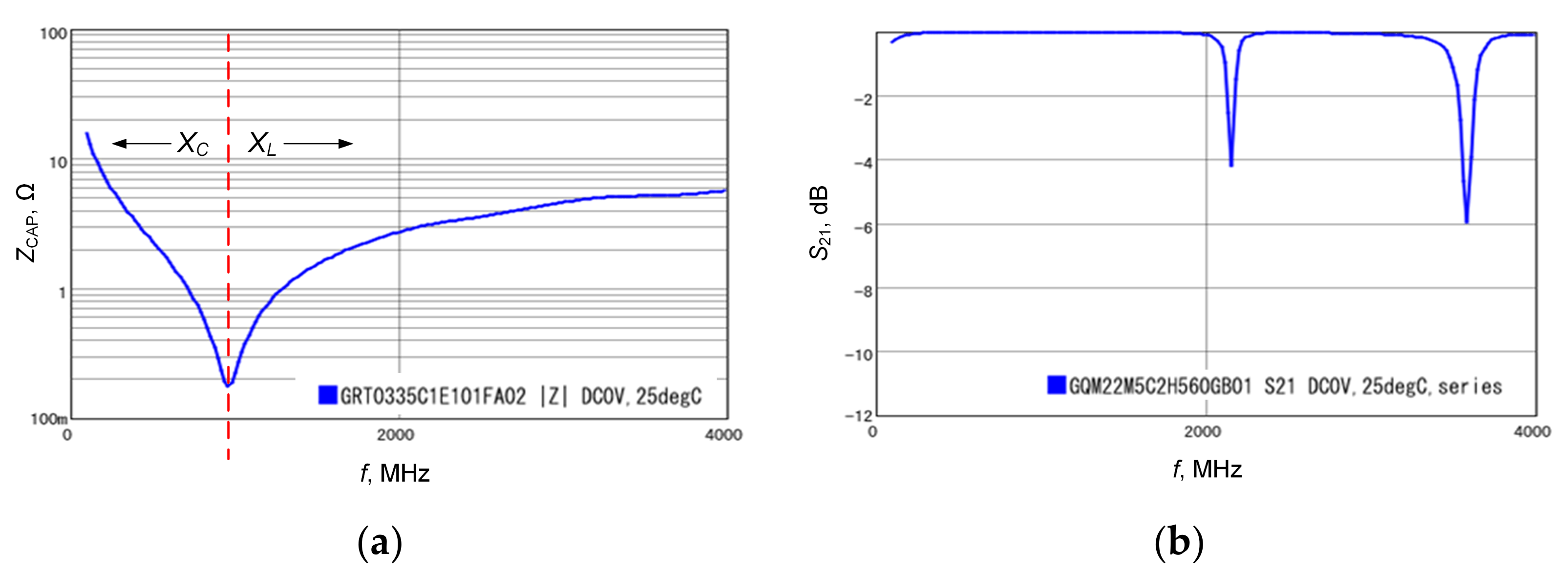
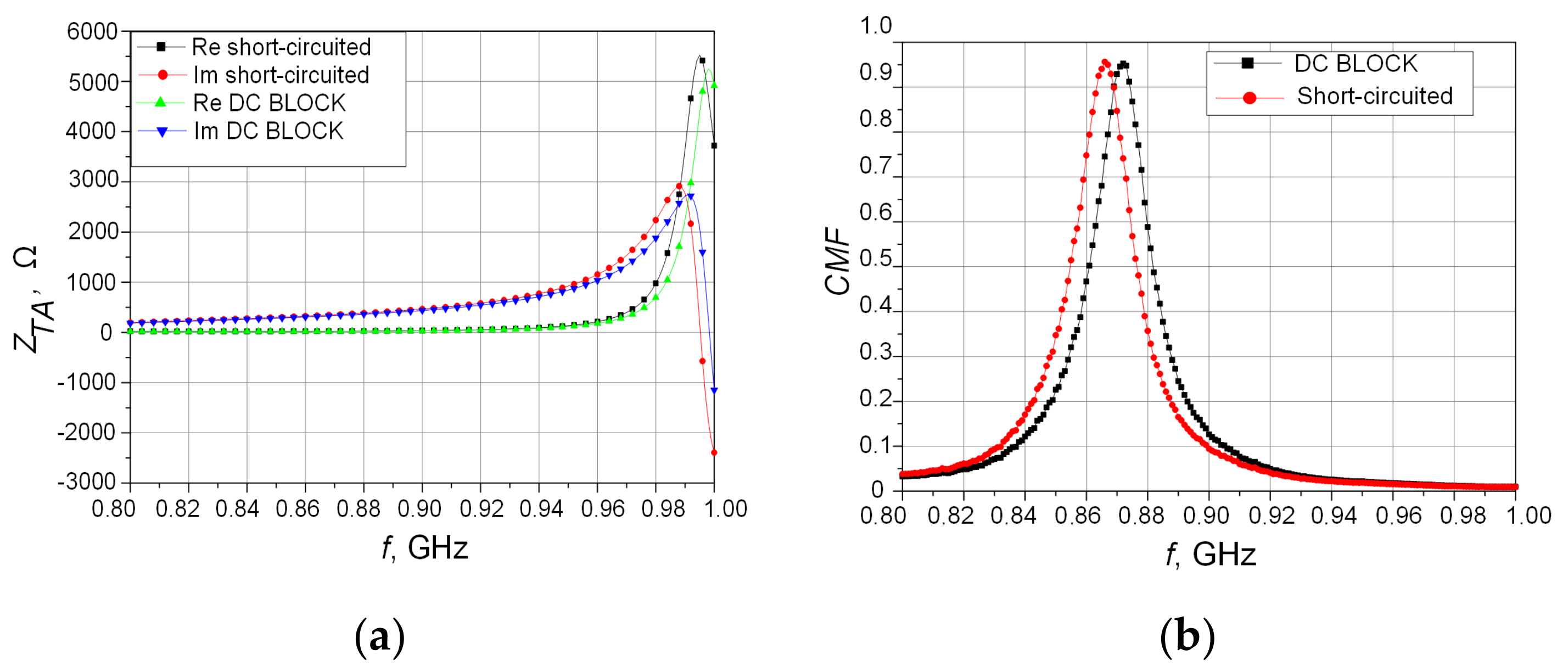
References
- Finkenzeller, K. RFID Handbook—Fundamentals and Applications in Contactless Smart Cards, Radio Frequency Identification and Near-Field Communication, 3rd ed.; Wiley: West Sussex, UK, 2010. [Google Scholar]
- Costa, F.; Genovesi, S.; Borgese, M.; Michel, A.; Dicandia, F.A.; Manara, G. A Review of RFID Sensors, the New Frontier of Internet of Things. Sensors 2021, 21, 3138. [Google Scholar] [CrossRef] [PubMed]
- Erman, F.; Hanafi, E.; Lim, E.-H.; Wan Mohd Mahyiddin, W.A.; Harun, S.W.; Umair, H.; Soboh, R.; Makmud, M.Z.H. Miniature Compact Folded Dipole for Metal Mountable UHF RFID Tag Antenna. Electronics 2019, 8, 713. [Google Scholar] [CrossRef]
- Chung, Y.; Berhe, T.H. Long-Range UHF RFID Tag for Automotive License Plate. Sensors 2021, 21, 2521. [Google Scholar] [CrossRef] [PubMed]
- El Khamlichi, M.; Alvarez Melcon, A.; El Mrabet, O.; Ennasar, M.A.; Hinojosa, J. Flexible UHF RFID Tag for Blood Tubes Monitoring. Sensors 2019, 19, 4903. [Google Scholar] [CrossRef] [PubMed]
- Franchina, V.; Ria, A.; Michel, A.; Bruschi, P.; Nepa, P.; Salvatore, A. A Compact UHF RFID Ceramic Tag for High-Temperature Applications. In Proceedings of the 2019 IEEE International Conference on RFID Technology and Applications (RFID-TA), Pisa, Italy, 25–27 September 2019; pp. 480–483. [Google Scholar] [CrossRef]
- Jankowski-Mihułowicz, P.; Węglarski, M. Definition, Characteristics and Determining Parameters of Antennas in Terms of Synthesizing the Interrogation Zone in RFID Systems. In Radio Frequency Identification; Crepaldi, P.C., Pimenta, T.C., Eds.; IntechOpen: London, UK, 2017; Chapter 5; pp. 65–119. ISBN 978-953-51-3630-9. [Google Scholar] [CrossRef]
- Khadka, G.; Hwang, S.-S. Tag-to-Tag Interference Suppression Technique Based on Time Division for RFID. Sensors 2017, 17, 78. [Google Scholar] [CrossRef] [PubMed]
- ISO/IEC 18000-63. Information Technology—Radio Frequency Identification for Item Management—Part 63: Parameters for Air Interface Communications at 860 MHz to 960 MHz Type C; International Organization for Standardization: Geneva, Switzerland, 2015. [Google Scholar]
- GS1 EPCglobal. EPC Radio-Frequency Identity Protocols Generation-2 UHF RFID; Specification for RFID Air Interface Protocol for Communications at 860 MHz–960 MHz; ver. 2.0.1; EPCglobal: Brussels, Belgium, April 2015. [Google Scholar]
- ETSI EN 302 208. Radio Frequency Identification Equipment Operating in the Band 865 MHz to 868 MHz with Power Levels up to 2 W and in the Band 915 MHz to 921 MHz with Power Levels up to 4 W; Harmonised Standard Covering the Essential Requirements of Article 3.2 of the Directive 2014/53/EU, v.3.1.1; European Telecommunications Standards Institute: Sophia-Antipolis, France, 2016. [Google Scholar]
- Code of Federal Regulations. Title 47. Telecommunication. Part 15.247 Operation within the bands 902–928 MHz, 2400–2483.5 MHz, and 5725–5850 MHz; Published by the Office of the Federal Register National Archives and Records Administration as a Special Edition of the Federal Register: Washington, DC, USA, October 2020. [Google Scholar]
- Marrocco, G. The art of UHF RFID antenna design: Impedance-matching and size-reduction techniques. IEEE Antennas Propag. Mag. 2008, 50, 66–79. [Google Scholar] [CrossRef]
- Węglarski, M.; Jankowski-Mihułowicz, P.; Chamera, M.; Dziedzic, J.; Kwaśnicki, P. Designing Antennas for RFID Sensors in Monitoring Parameters of Photovoltaic Panels. Micromachines 2020, 11, 420. [Google Scholar] [CrossRef] [PubMed]
- Hussain, M.; Amin, Y.; Lee, K.-G. A Compact and Flexible UHF RFID Tag Antenna for Massive IoT Devices in 5G System. Sensors 2020, 20, 5713. [Google Scholar] [CrossRef] [PubMed]
- Phatarachaisakul, T.; Pumpoung, T.; Phongcharoenpanich, C. Dual-band RFID tag antenna with EBG for glass objects. In Proceedings of the IEEE 4th Asia-Pacific Conference on Antennas and Propagation (APCAP), Bali, Indonesia, 30 June–3 July 2015; pp. 199–200. [Google Scholar] [CrossRef]
- Lu, J.H.; Wu, J.J. UHF band RFID tag antenna mounted on glass objects. In Proceedings of the IEEE Asia Pacific Microwave Conference, Singapore, 7–10 December 2009; pp. 622–624. [Google Scholar] [CrossRef]
- Lu, J.H.; Chang, B.S. Planar Compact Square-Ring Tag Antenna with Circular Polarization for UHF RFID Applications. IEEE Trans. Antennas Propag. 2017, 65, 432–441. [Google Scholar] [CrossRef]
- Pan, T.; Zhang, S.; He, S. Compact RFID Tag Antenna with Circular Polarization and Embedded Feed Network for Metallic Objects. IEEE Antennas Wirel. Propag. Lett. 2014, 13, 1271–1274. [Google Scholar] [CrossRef]
- Lukas, I.J.; Qing, X.; Chen, Z.N.; Alphones, A. UHF omnidirectional bent dipole antenna for item-level RFID applications. In Proceedings of the IEEE Antennas and Propagation Society International Symposium, San Diego, CA, USA, 5–11 July 2008; pp. 1–4. [Google Scholar] [CrossRef]
- Kaiwen, K.T.; Qing, X.; Goh, C.K.; Zhu, L. A UHF omni-directional RFID antenna. In Proceedings of the IEEE Antennas and Propagation Society International Symposium, Toronto, ON, Canada, 11–17 July 2010; pp. 1–4. [Google Scholar] [CrossRef]
- Jankowski-Mihułowicz, P.; Lichoń, W.; Pitera, G.; Węglarski, M. Determination of the Material Relative Permittivity in the UHF Band by Using T and Modified Ring Resonators. Int. J. Electron. Telecommun. 2016, 62, 129–134. [Google Scholar] [CrossRef][Green Version]
- ISOLA. FR408 High Performance Laminate and Prepreg, Data Sheet; Isola Group: Chandler, AZ, USA, 2018. [Google Scholar]
- DuPont. Pyralux LF Copper-Clad Laminates—Flexible Composites, Data Sheet, H-73244-5 06/12, USA; DuPont Electronic Technologies: Wilmington, DE, USA, 2012. [Google Scholar]
- Pilkington. NSG TEC; Datasheet; Pilkington: Deutschland, AG, USA, 2018. [Google Scholar]
- Krupka, J.; Gregory, A.P.; Rochard, O.C.; Clarke, R.N.; Riddle, B.; Baker-Jarvis, J. Uncertainty of complex permittivity measurements by split-post dielectric resonator technique. J. Eur. Ceram. Soc. 2001, 21, 2673–2676. [Google Scholar] [CrossRef]
- Jankowski-Mihułowicz, P.; Węglarski, M.; Lichoń, W. A Procedure for Validating Impedance Parameters of HF/UHF RFID Transponder Antennas. In Methods and Techniques of Signal Processing in Physical Measurements; Hanus, R., Mazur, D., Kreischer, C., Eds.; MSM2018. Lecture Notes in Electrical Engineering; Springer: Cham, Switzerland, 2019; Volume 548, pp. 101–118. ISBN 978-3-030-11186-1. [Google Scholar] [CrossRef]
- Ali, W.; AI-Charchafchi, S.H. Using Equivalent Constant to Simplify the Analisys of Patch Microstrip Antenna with Multi Layer Substrates. In Proceedings of the IEEE Antennas and Propagation Society International Symposium, Atlanta, GA, USA, 21–26 June 1998. [Google Scholar] [CrossRef]
- Mentor Graphics: IE3D User Manual; Mentor Graphics: Wilsonville, OR, USA, 2012.
- O’Conchubhair, O.; McEvoy, P.; Ammann, M.J. Dye-Sensitized Solar Cell Antenna. IEEE Antennas Wirel. Propag. Lett. 2016, 16, 352–355. [Google Scholar] [CrossRef]
- SCHOTT. D263 Thin Glass, Technical Documentation; Schott AG: Mainz, Germany, 2013. [Google Scholar]
- Material: Indium Tin Oxide (ITO). Available online: www.mit.edu/~6.777/matprops/ito.htm (accessed on 20 November 2017).
- Zhu, L.U.; Zhang, L.D.; Fang, Q. X-ray photoelectron spectroscopystudy of ZrO2/TiO2/Si stack. Appl. Phys. Lett. 2007, 91, 17. [Google Scholar] [CrossRef]
- Jovanovski, V.; Stathatos, E.; Orel, B.; Lianos, P. Dye-sensitized solarcells with electrolyte based on a trimethoxysilane-derived ionic liquid. Thin Solid Films 2006, 511, 634–637. [Google Scholar] [CrossRef]
- American Technical Ceramics. Capacitors in Broadband Applications; Application Note, ATC # 001-951, Rev. D 1/05; American Technical Ceramics: Huntington Station, NY, USA, 2001. [Google Scholar]
- American Technical Ceramics. Capacitors in Coupling and DC Block Applications, Circuit Designer’s Notebook; Document #001-927, Rev. E, 1/05; American Technical Ceramics: Huntington Station, NY, USA, 2001. [Google Scholar]
- Semtech. RF Design Guidelines: PCB Layout Circuit Optimization; Application Note, AN 1200.04; Semtech: Camarillo, CA, USA, 2006. [Google Scholar]
- Infineon Technologies. ESD Protection for RF Antennas Using Infineon ESD0P4RFL and ESD0P2RF; Application Note, Rev. 1.0; Infineon Technologies: Neubiberg, Germany, 2008. [Google Scholar]
- MULTICOMP. General Purpose Multilayer Ceramic Capacitors—4 to 100V (NP0, X5R, X7R & Y5V Dielectrics), Data Sheet; Farnell: Chicago, IL, USA, 2018. [Google Scholar]
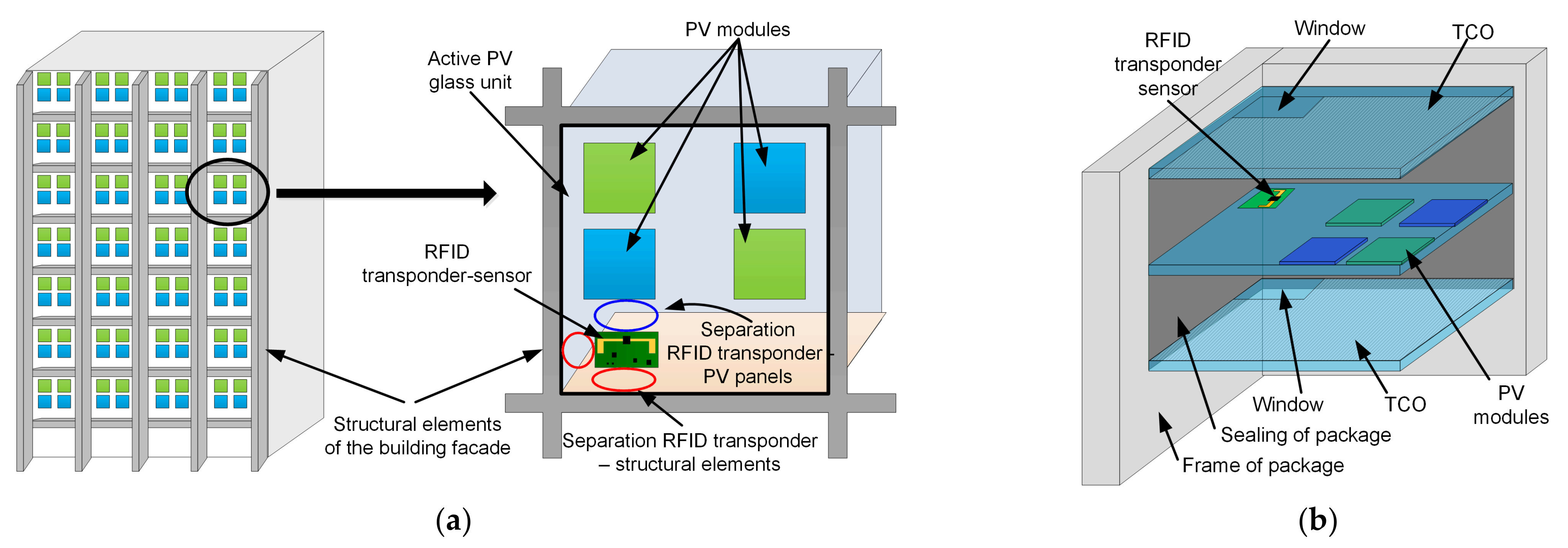


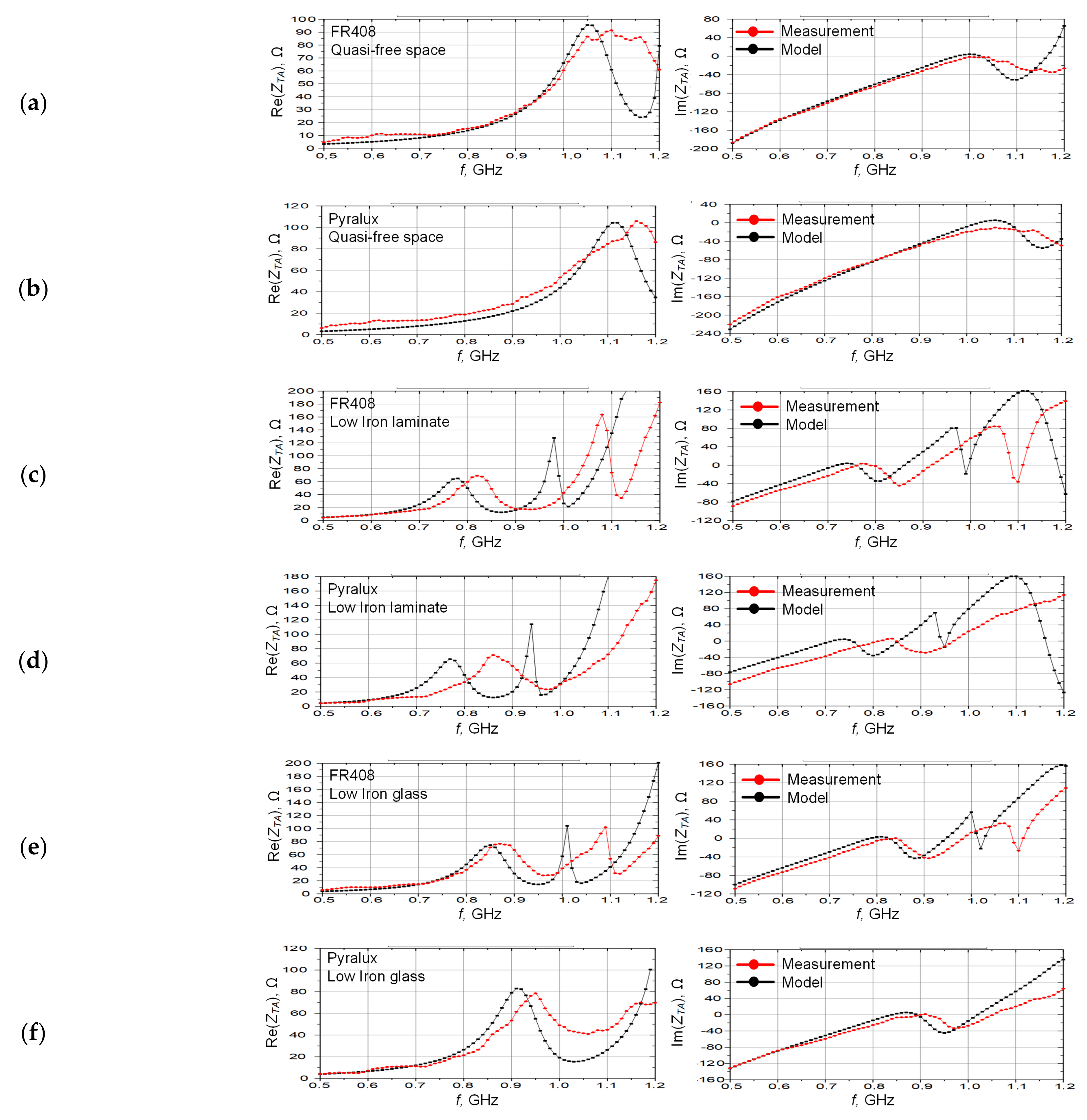

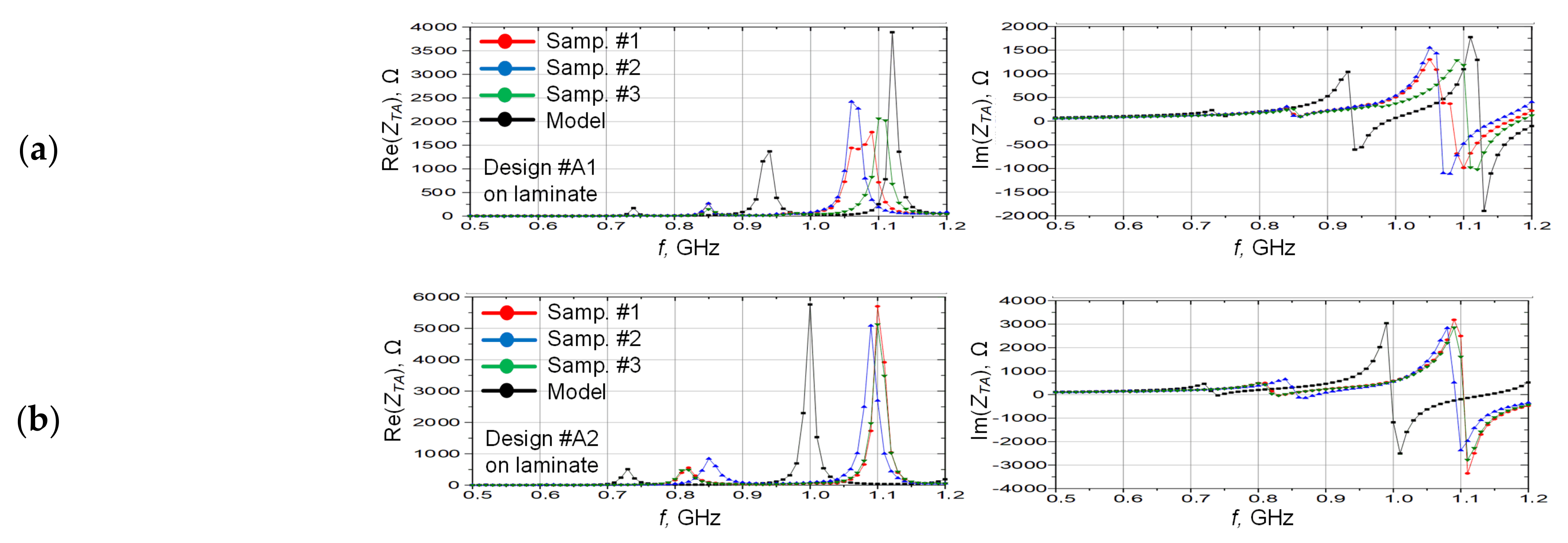




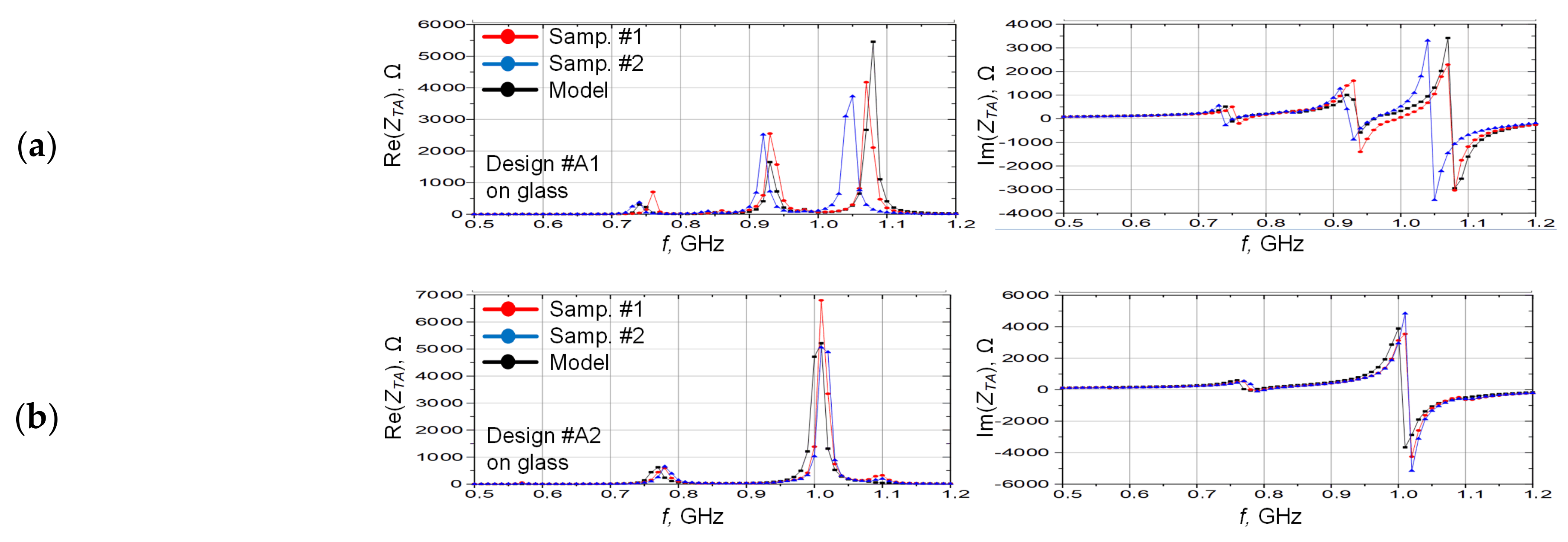

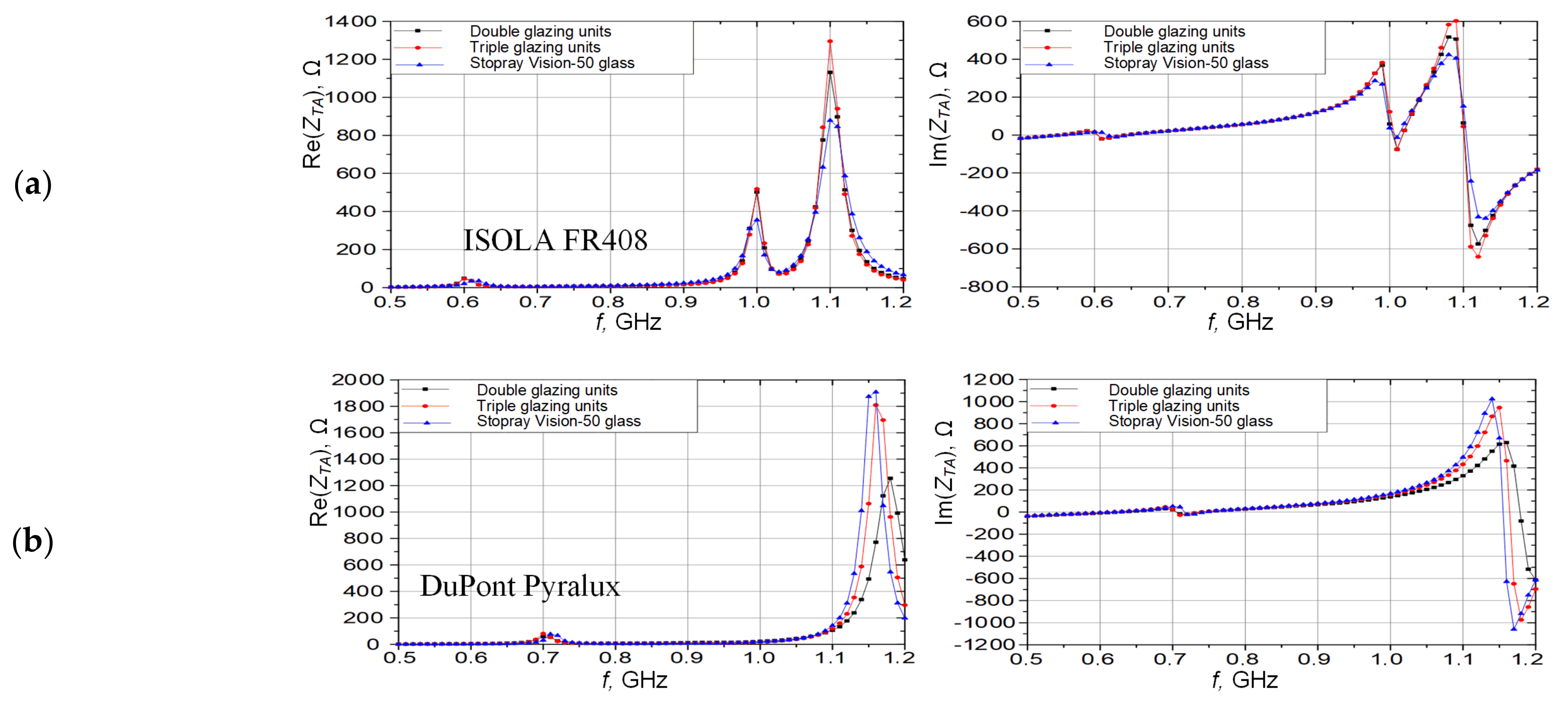

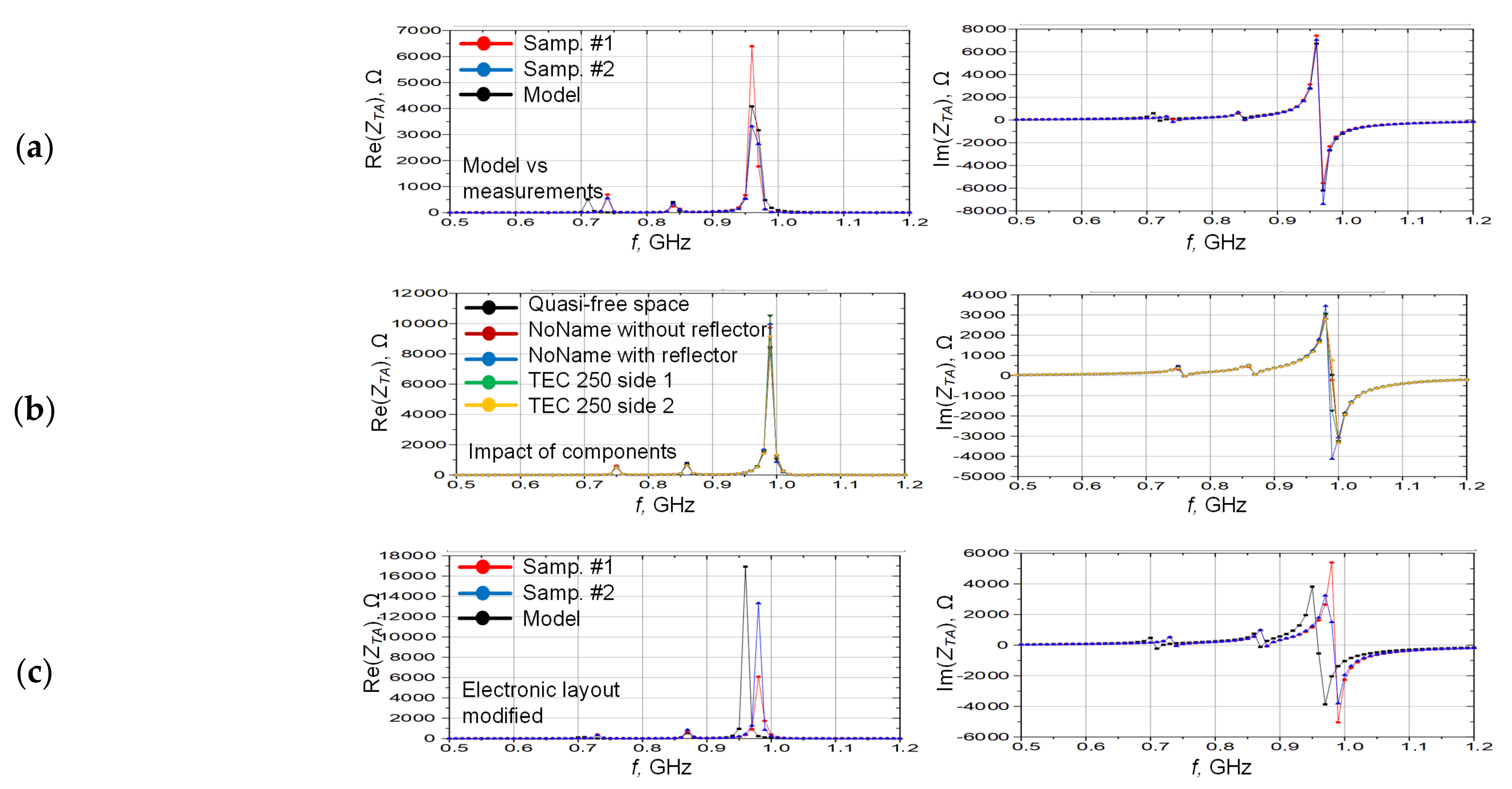
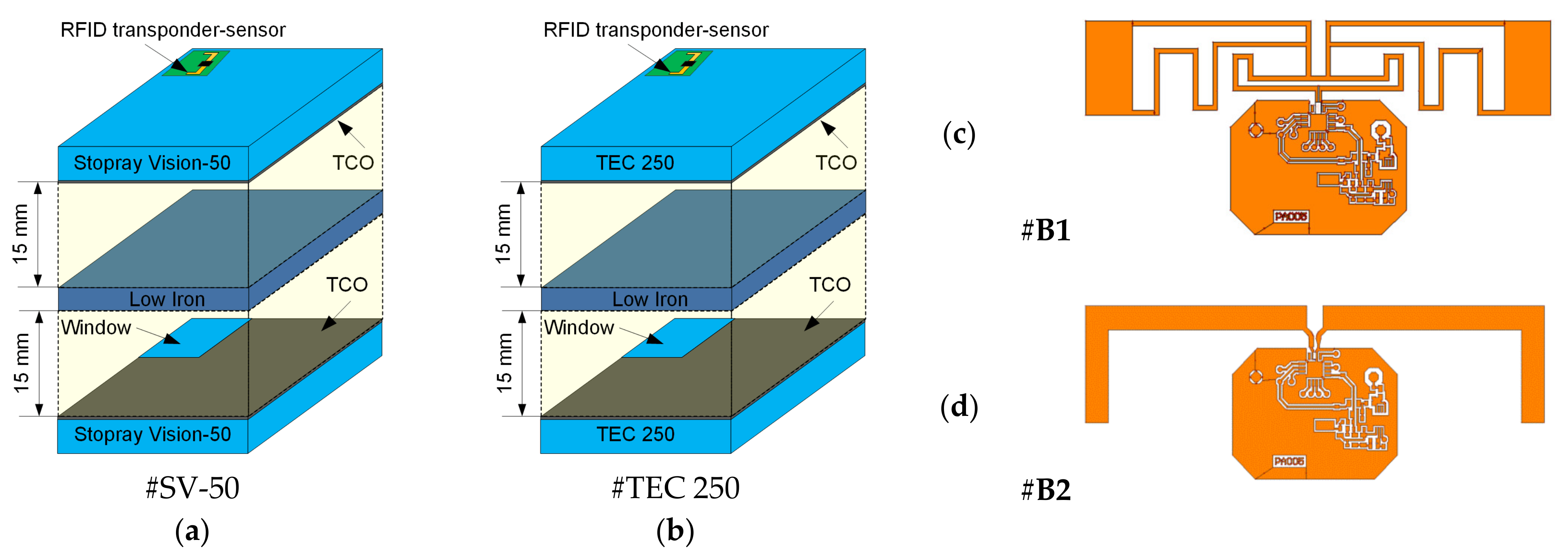

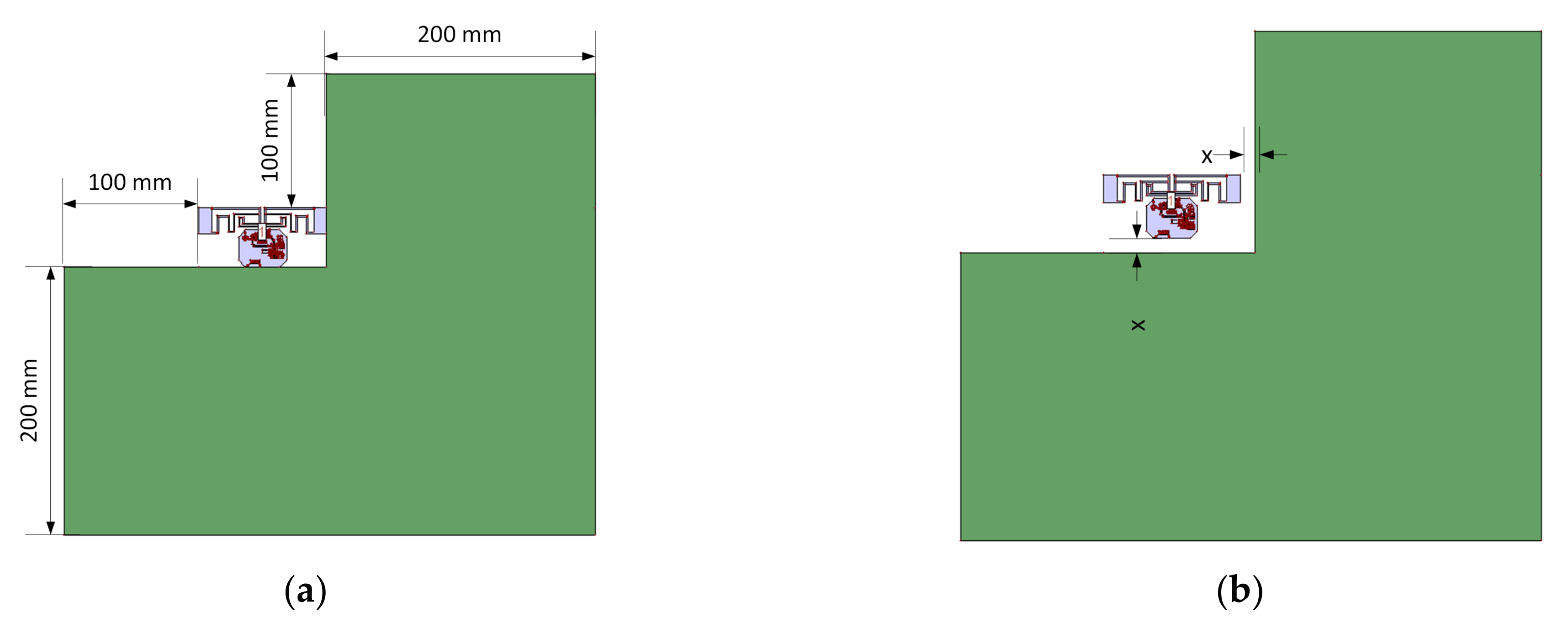
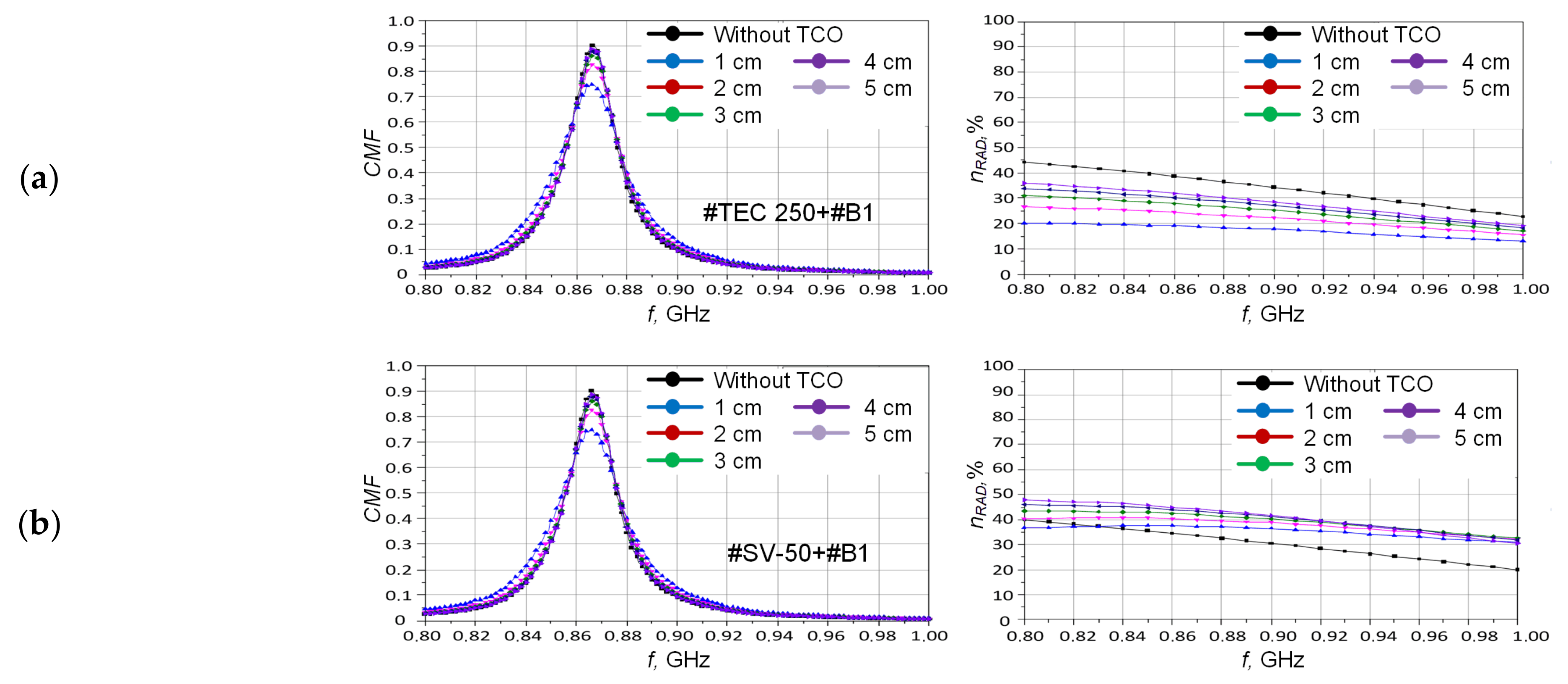
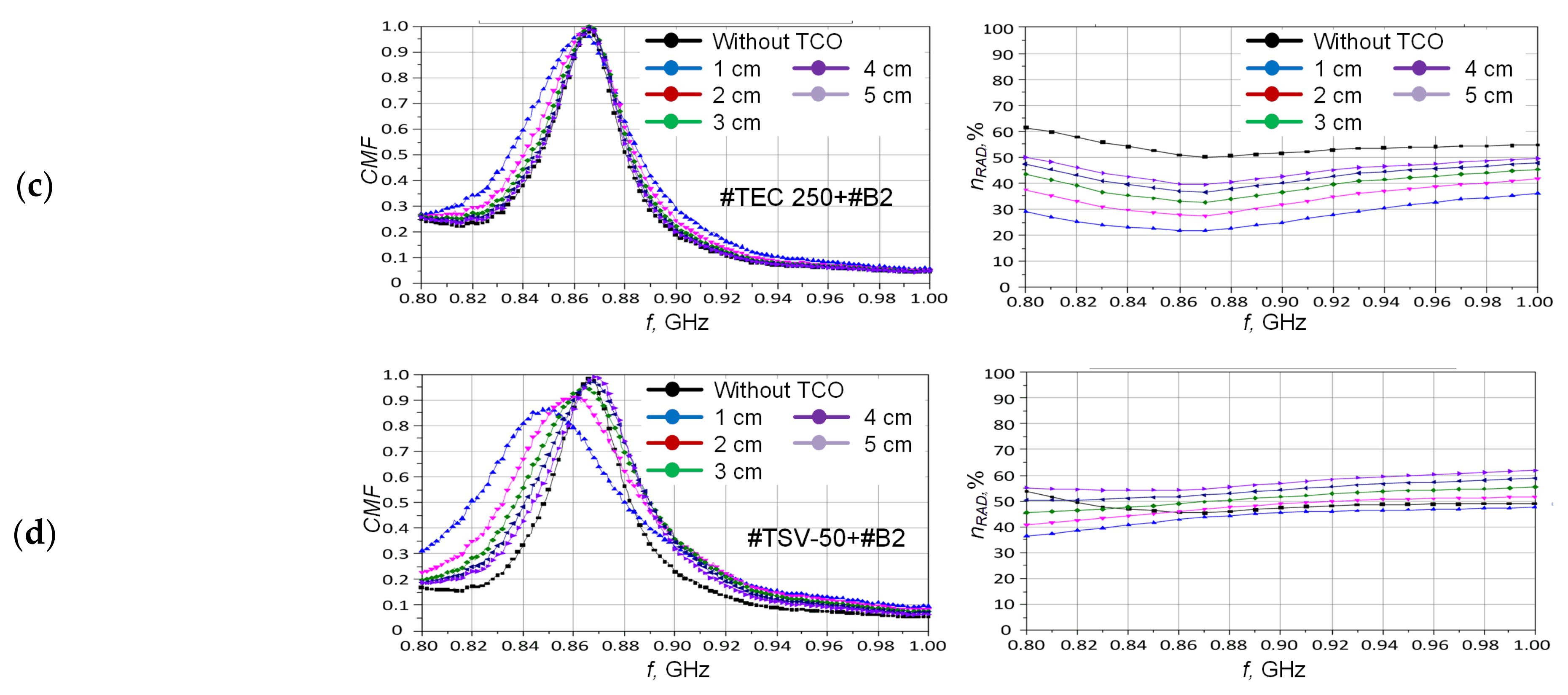

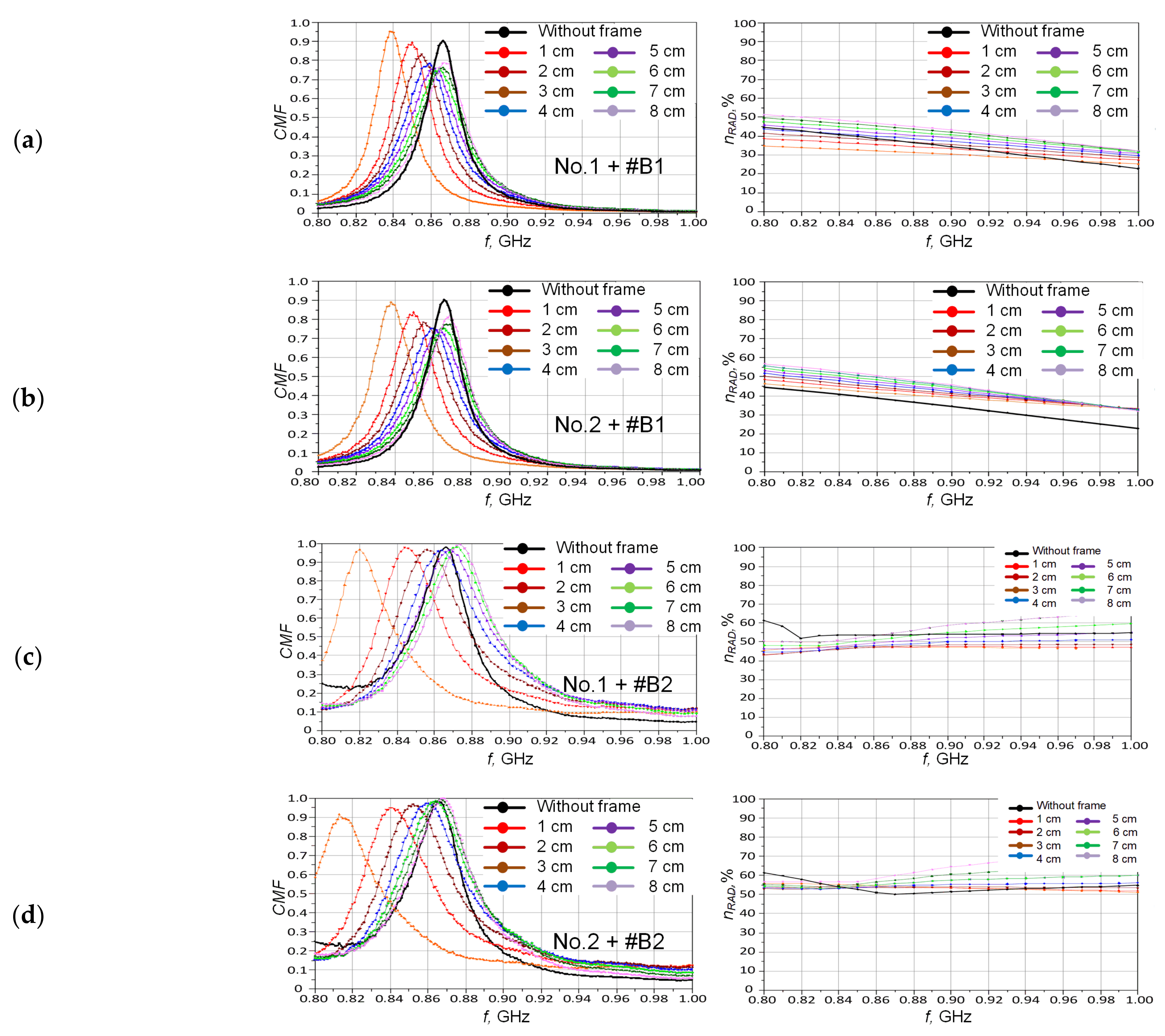


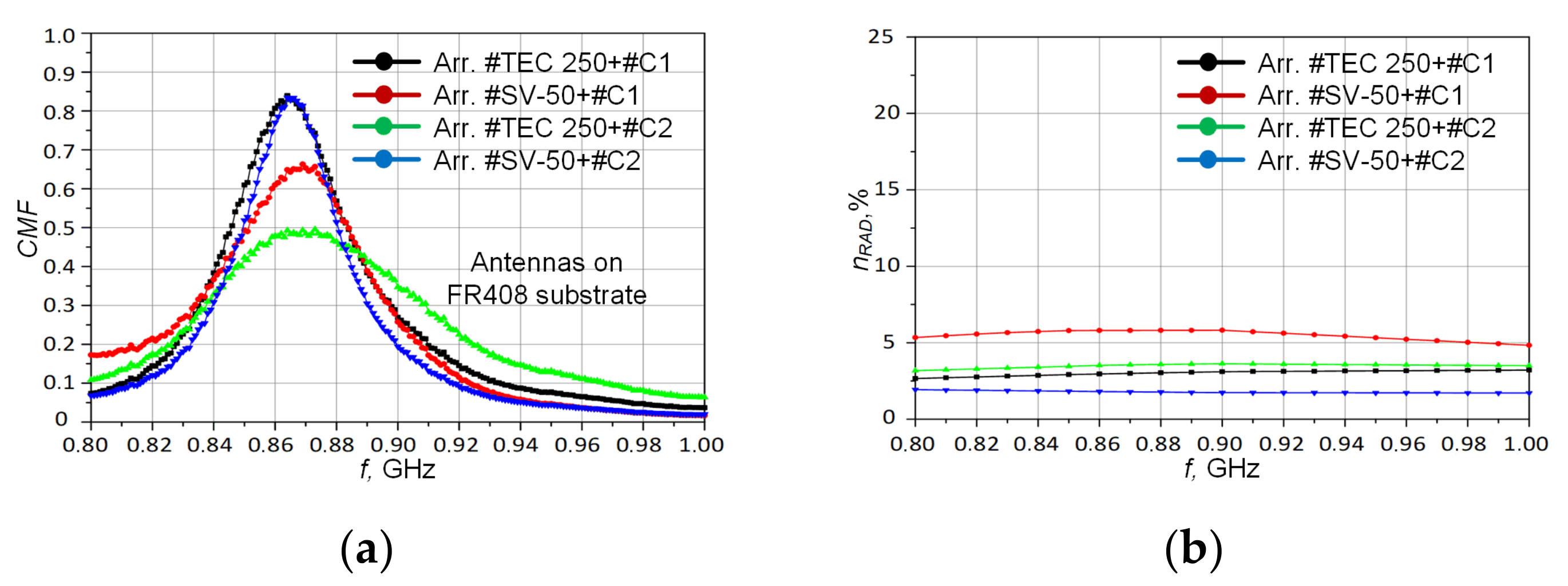




| Pos. | Name of Dielectric Material | Thickness, mm | εr | tgδ |
| 1. | Glass: Low Iron | 1.92 | 7.00 | 9.290·10−3 |
| 2. | Laminate: Low Iron + SKC EVA sheet + Low Iron | 4.24 | 6.61 | 9.423·10−3 |
| 3. | Pikligton NSG TEC 250 | 3.21 | 6.8 | 9.000·10−3 |
| 4. | AGC Stopray Vision-50 | 5.864 | 5.0 | 9.000·10−3 |
| 5. | ISOLA FR408 | 0.51 | 4.44 | 9.605·10−3 |
| 6. | DuPont Pyralux LF9150R | 0.125 | 3.55 | 9.200·10−3 |
| 7. | ISOLA IS-680-300 microwave | 1.547 | 3.08 | 3.000·10−3 |
| Pos. | Name of Functional Layer | Thickness, µm | R, Ω/▯ | δ,S/m |
| 1 | TCO (NSG TEC 250) | 0.5 | 300 | |
| 2 | TCO (Stopray Vison-50) | 0.5 | 5 | |
| 3 | Cu clad (FR408) | 18 | 4.8·108 | |
| 4 | Cu clad (Pyralux LF9150R) | 35 | 4.8·108 |
Publisher’s Note: MDPI stays neutral with regard to jurisdictional claims in published maps and institutional affiliations. |
© 2021 by the authors. Licensee MDPI, Basel, Switzerland. This article is an open access article distributed under the terms and conditions of the Creative Commons Attribution (CC BY) license (https://creativecommons.org/licenses/by/4.0/).
Share and Cite
Jankowski-Mihułowicz, P.; Węglarski, M.; Lichoń, W.; Chamera, M.; Pyt, P.; Ciejka, C. Synthesis of Antennas for Active Glazing Unit with Photovoltaic Modules. Energies 2021, 14, 6632. https://doi.org/10.3390/en14206632
Jankowski-Mihułowicz P, Węglarski M, Lichoń W, Chamera M, Pyt P, Ciejka C. Synthesis of Antennas for Active Glazing Unit with Photovoltaic Modules. Energies. 2021; 14(20):6632. https://doi.org/10.3390/en14206632
Chicago/Turabian StyleJankowski-Mihułowicz, Piotr, Mariusz Węglarski, Wojciech Lichoń, Mateusz Chamera, Patryk Pyt, and Cezary Ciejka. 2021. "Synthesis of Antennas for Active Glazing Unit with Photovoltaic Modules" Energies 14, no. 20: 6632. https://doi.org/10.3390/en14206632
APA StyleJankowski-Mihułowicz, P., Węglarski, M., Lichoń, W., Chamera, M., Pyt, P., & Ciejka, C. (2021). Synthesis of Antennas for Active Glazing Unit with Photovoltaic Modules. Energies, 14(20), 6632. https://doi.org/10.3390/en14206632







